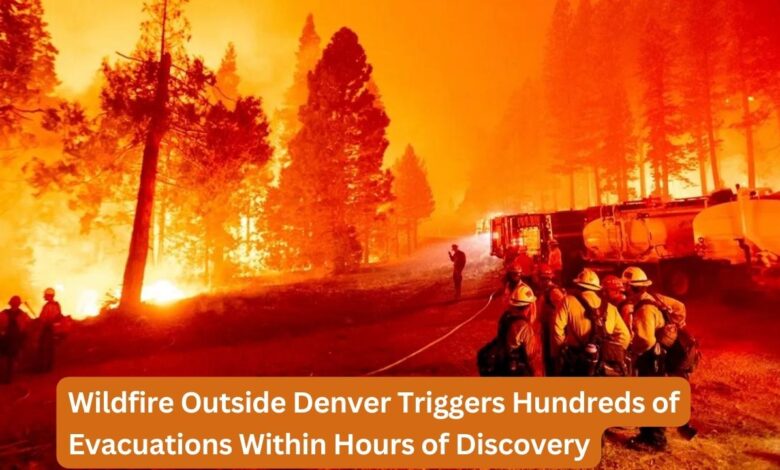Wildfire Outside Denver Triggers Hundreds of Evacuations Within Hours of Discovery

Wildfires have become an increasingly alarming issue across the western United States, and the recent wildfire outside Denver is a stark reminder of the urgent need for vigilance and preparedness. Within just a few hours, what began as a small spot fire rapidly expanded, forcing hundreds of people in central Colorado to evacuate their homes overnight.
The Rapid Spread of the Denver Wildfire
Initial Discovery and Rapid Expansion
Around 9 p.m. on a Tuesday evening, a deputy patrolling an area of unincorporated Jefferson County, located just southwest of Denver, noticed a small fire roughly 10 feet wide. This seemingly minor incident quickly escalated. Mark Techmeyer, a spokesperson for the sheriff’s office, reported at a Wednesday morning news conference that within three hours, the fire had spread across 100 acres of mountainous terrain. This rapid growth underscores the unpredictable and dangerous nature of wildfires.
By Wednesday morning, officials estimated that the wildfire had grown to approximately 130 acres. A helicopter was expected to provide a more precise measurement later in the day. Multiple agencies responded to the wildfire overnight, issuing reverse 911 messages and going door-to-door to wake residents and instruct them to evacuate. Nearly 600 homes were evacuated, illustrating the severe and immediate threat posed by the wildfire.
The Immediate Impact on the Community
Evacuation and Emergency Response
The sudden and rapid expansion of the wildfire necessitated swift action to ensure the safety of residents. Authorities implemented reverse 911 notifications and physically knocked on doors to alert and evacuate nearly 600 homes. This large-scale evacuation operation demonstrated the coordinated efforts of multiple agencies working together to protect lives and property.
Emergency shelters were established to accommodate displaced residents, providing a temporary refuge while the fire was being contained. Local community centers, schools, and churches opened their doors to those affected, offering support and essential services. The quick response and organized evacuation efforts likely saved lives and mitigated potential injuries.
Community Response and Support
The community’s response to the wildfire was marked by resilience and solidarity. Volunteers and local organizations rallied to support evacuees, providing food, clothing, and emotional support. Social media platforms were abuzz with messages of assistance, as neighbors checked in on each other and offered help. The spirit of cooperation and empathy was palpable, showcasing the strength of the community in times of crisis.
The Challenges of Containing the Wildfire
Difficult Terrain and Weather Conditions
The mountainous terrain of Jefferson County presented significant challenges for firefighting efforts. The rugged landscape made it difficult for ground crews to access certain areas, necessitating the use of aerial resources. Helicopters and planes were deployed to drop water and fire retardant, aiming to slow the spread of the flames.
Weather conditions further complicated containment efforts. Winds can dramatically influence the direction and intensity of a wildfire, and shifting wind patterns posed a constant threat to both firefighters and residents. Despite these challenges, the coordinated efforts of firefighting teams made progress in controlling the blaze.
Resource Allocation and Coordination
Fighting a wildfire of this magnitude requires extensive resources and coordination. Fire departments from surrounding areas were called in to assist, bringing additional personnel and equipment. Federal and state agencies also played a crucial role, providing specialized resources and expertise.
The Incident Command System (ICS) was activated to manage the response, ensuring a structured and efficient approach. This system allows for effective communication and coordination among various agencies, optimizing resource allocation and strategic planning. The collaborative efforts of all involved were critical in addressing the wildfire emergency.
The Broader Context of Wildfires in the Western United States
Increasing Frequency and Intensity
The wildfire outside Denver is part of a broader trend of increasing wildfire frequency and intensity across the western United States. Factors such as climate change, prolonged droughts, and higher temperatures have created conditions conducive to wildfires. As a result, communities in wildfire-prone areas are facing unprecedented challenges.
Environmental and Economic Impacts
Wildfires have far-reaching environmental and economic impacts. The immediate destruction of homes and infrastructure is often followed by longer-term consequences such as soil erosion, water contamination, and loss of wildlife habitat. The economic costs of wildfires are also significant, encompassing firefighting expenses, property damage, and lost revenue from disrupted businesses.
Adapting to a New Reality
In light of the increasing threat of wildfires, communities and policymakers are exploring ways to adapt and mitigate risks. This includes implementing stricter building codes, enhancing early warning systems, and investing in fire-resistant infrastructure. Additionally, efforts to restore natural ecosystems and reduce fuel loads through controlled burns are being prioritized.
Personal Stories and Human Impact
Evacuee Experiences
For the hundreds of people evacuated from their homes, the wildfire was a traumatic and life-altering event. Families were forced to leave behind their belongings and seek refuge in emergency shelters. The uncertainty and fear of losing their homes weighed heavily on evacuees, highlighting the human toll of such disasters.
Many evacuees shared their stories of resilience and hope. Despite the challenges, there were numerous accounts of neighbors helping each other, volunteers providing support, and a sense of community solidarity. These personal stories underscored the strength and compassion that emerge in times of crisis.
First Responders on the Front Lines
The bravery and dedication of first responders were evident throughout the wildfire emergency. Firefighters, law enforcement officers, and emergency medical personnel worked tirelessly to protect lives and property. Their efforts were crucial in ensuring a safe and organized evacuation, as well as in battling the blaze.
First responders often face dangerous and grueling conditions, putting their lives on the line to serve their communities. Their commitment to public safety is a testament to their courage and professionalism.
Moving Forward: Recovery and Preparedness
Rebuilding and Recovery Efforts
As the wildfire is brought under control, attention will turn to recovery and rebuilding efforts. Assessing the damage and providing support to affected residents will be a priority. Government agencies, non-profits, and community organizations will collaborate to offer financial assistance, counseling services, and resources for rebuilding.
Enhancing Preparedness
The wildfire outside Denver serves as a reminder of the importance of preparedness. Communities in wildfire-prone areas must continue to develop and refine emergency plans, ensuring that residents are informed and ready to act. Public education campaigns can raise awareness about wildfire risks and safety measures.
Investing in infrastructure and technology is also key to enhancing preparedness. Advanced early warning systems, improved communication networks, and robust firefighting resources can help mitigate the impact of future wildfires.
Conclusion
The wildfire outside Denver, which triggered hundreds of evacuations within hours of discovery, is a stark reminder of the urgent and ongoing threat posed by wildfires. The rapid spread of the fire, the challenges faced by first responders, and the resilience of the community all highlight the complex and multifaceted nature of wildfire emergencies. As we move forward, it is essential to prioritize preparedness, invest in mitigation efforts, and support affected communities in their recovery.




